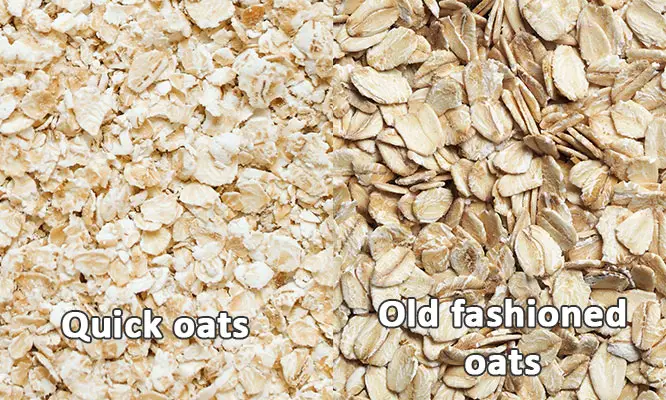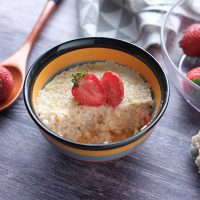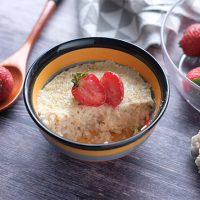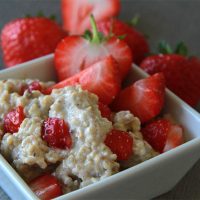If you’re a fan of oatmeal, then you may have noticed that there are many varieties of oats available in the supermarket. From old-fashioned rolled oats to quick-cooking oats and steel-cut oats, it can be difficult to know which type is best for your breakfast bowl.
In this guide, we will look at the differences between old fashioned oats vs quick oats so you can make an informed decision about what kind of oat is right for you. We’ll also discuss how old fashioned oats compare to rolled oats and steel cut oats. By the end, you’ll understand exactly which type of oat suits your needs. So let’s dive in!
What are old fashioned oats?
Old fashioned oats, also known as rolled oats or whole oats, are the most traditional and basic type of oat. These thick, flat grains are made by steaming oat kernels before rolling them into flakes. They cook quite quickly and have a mild flavor that makes them a versatile addition to both sweet and savory dishes.
Are old-fashioned oats the same as quick oats?
No, old-fashioned oats are not the same as quick oats. While both types of oats are made from the same type of grain, old-fashioned oats are rolled flat and then steamed, while quick oats have been cut into smaller pieces before being rolled. This results in a softer texture and faster cooking time for quick oats.
What are the Differences Between Old Fashioned and Quick Oats?
While both types of oats are considered good sources of dietary fiber and protein, there are some distinct differences between them that make one more suitable for certain recipes than the other.

Texture and Size Difference
The first difference between old-fashioned oats and quick oats is their size and texture. Old-fashioned oats, also known as rolled oats, are usually larger in size and have a slightly chewy texture. This makes them ideal for oatmeal cookies, granola bars, or overnight oatmeal recipes, because they will hold their shape better when baked.
In contrast, quick oats are much finer in texture with a thinner consistency than old-fashioned oats. This makes them ideal for quicker cooking applications such as hot cereal or smoothies.
Cooking Time Difference
One of the biggest differences between old-fashioned and quick oats is the cooking time required to prepare each variety.
Quick oats take less time to cook than old-fashioned oat flakes because they have been cut into small pieces before being processed. They usually only need to be cooked for about one minute, compared to three minutes for old-fashioned rolled oats if you’re using stovetop preparation methods like boiling water or milk on high heat.
Versatility and Flavor Difference
Old-fashioned oats tend to have a milder, slightly nutty flavor that makes them an excellent choice for both sweet and savory dishes. They can be used in cookies, granola bars, or overnight oatmeal recipes due to their size and texture.
In contrast, quick oats are more suitable for hot cereal or smoothies because they tend to have a softer, slightly sweeter flavor.
Quick oats vs old fashioned – Nutrition
To see whether quick oats or old fashioned oats are the healthier choice, let’s take a look at the nutritional profiles of each type. For the purpose of this comparison, we will compare Quick 1-Minute Oats by Quaker vs Old Fashioned Quaker oats.
| NUTRITIONAL VALUES per 1/2 cup serving (40g) | QUICK 1-MINUTE QUAKER OATS | OLD FASHIONED QUAKER OATS |
| Calories | 150 | 150 |
| Carbs | 27g | 27g |
| Fat | 3g | 3g |
| Fiber | 4g | 4g |
| Protein | 5g | 5g |
As you can see, both types of oats have the same basic nutritional profile, with the same number of calories, carbs, and grams of fat and protein per serving.
Overall, both types of oats are healthy and nutritious food choices that can be incorporated into a balanced diet.
Can you use old fashioned oats instead of quick oats?
Yes, it is possible to use old-fashioned oats in place of quick oats in most recipes. However, you may need to adjust the cooking time and/or liquid amount depending on the recipe you are using. For example, if your recipe calls for 2 cups of quick oats but only 1 cup of old-fashioned rolled oats, then you would need to add 1 cup of extra liquid. Additionally, you will likely need to cook the oats for a longer time on the stove or in an oven if using old-fashioned oats.
So if your recipe calls for 5-7 minutes of cooking time, you may need to cook old-fashioned oats for 10-12 minutes in order to achieve a soft and creamy consistency. Overall, the best way to know how much liquid and cooking time is required to use old-fashioned oats instead of quick oats is by testing out a small batch of oats and seeing if the texture and flavor work for your recipe.
Old fashioned oats vs steel cut oats – what’s the difference?
Old-fashioned oats have been steamed and rolled into flattened oat flakes to make them quicker to cook. Steel cut oats, also known as Irish or Pinhead oats, are made by cutting the groats into pieces with a steel blade.
As a result of this processing steel cut oats take longer to absorb liquid and cook than old-fashioned oats. Depending on what you’re looking for from your oat selection, either could be a great choice – but if you’re looking for a quicker cooking time, old-fashioned oats are your best bet.



